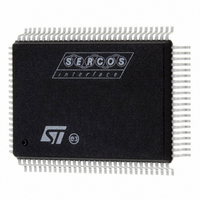ST92F150CV1QB STMicroelectronics, ST92F150CV1QB Datasheet - Page 295

ST92F150CV1QB
Manufacturer Part Number
ST92F150CV1QB
Description
MCU 8BIT 128K FLASH 100PQFP
Manufacturer
STMicroelectronics
Series
ST9r
Datasheet
1.ST92F150CV1TB.pdf
(429 pages)
Specifications of ST92F150CV1QB
Core Processor
ST9
Core Size
8/16-Bit
Speed
24MHz
Connectivity
CAN, I²C, LIN, SCI, SPI
Peripherals
DMA, LVD, POR, PWM, WDT
Number Of I /o
77
Program Memory Size
128KB (128K x 8)
Program Memory Type
FLASH
Eeprom Size
1K x 8
Ram Size
4K x 8
Voltage - Supply (vcc/vdd)
4.5 V ~ 5.5 V
Data Converters
A/D 16x10b
Oscillator Type
Internal
Operating Temperature
-40°C ~ 105°C
Package / Case
100-QFP
Processor Series
ST92F15x
Core
ST9
Data Bus Width
8 bit, 16 bit
Data Ram Size
6 KB
Interface Type
CAN, I2C, SCI, SPI
Maximum Clock Frequency
24 MHz
Number Of Programmable I/os
80
Number Of Timers
5 x 16 bit
Operating Supply Voltage
4.5 V to 5.5 V
Maximum Operating Temperature
+ 105 C
Mounting Style
SMD/SMT
Development Tools By Supplier
ST92F150-EPB
Minimum Operating Temperature
- 40 C
On-chip Adc
16 bit x 10 bit
Lead Free Status / RoHS Status
Lead free / RoHS Compliant
Other names
497-4882
Available stocks
Company
Part Number
Manufacturer
Quantity
Price
Company:
Part Number:
ST92F150CV1QB
Manufacturer:
STMicroelectronics
Quantity:
10 000
- Current page: 295 of 429
- Download datasheet (8Mb)
J1850 BYTE LEVEL PROTOCOL DECODER (Cont’d)
10.9.3.4 Sleep Mode
Sleep mode allows the user program to ignore the
remainder of a message. Normally, the user pro-
gram can recognise if the message is of interest
from the header bytes at the beginning of the mes-
sage. If the user program is not interested in the
message it simply writes the SLP bit in the PRLR
register. This causes all additional data on the bus
to be ignored until an EOF minimum occurs. No
additional flags (but not the EOFM flag) and, there-
fore, interrupts are generated for the remainder of
the message. The single exception to this is a re-
ceived break symbol while in sleep mode. Break
symbols always take precedence and will set the
RBRK bit in the ERROR register and generate an
interrupt if the ERR_M bit in IMR is set. Sleep
mode and the SLP bit gets cleared on reception of
an EOF or Break symbol.
Writes to the SLP bit will be ignored if:
1) A valid EOFM symbol was the last valid symbol
AND
2) The J1850 bus line (after the filter) is passive.
Therefore, sleep mode can only be invoked after
the SOF symbol and subsequent data has been
received, but before a valid EOF is detected. If
sleep mode is invoked within this time window,
then any queued IFR transmit is aborted. If a MSG
type is queued and sleep mode is invoked, then
the MSG type will remain queued and an attempt
to transmit will occur after the EOF period has
elapsed as usual.
If SLP mode is invoked while the JBLPD is current-
ly transmitting, then the JBLPD effectively inhibits
the RDRF, RDT, EODM, & RDOF flags from being
set, and disallows RXDATA transfers. But, it other-
wise functions normally as a transmitter, still allow-
Table 54. Normalization Bit configurations
IFR with CRC
IFR without CRC
detected,
Symbol
NB0
NB1
active Tv1 (active short)
active Tv2 (active long)
NBSYMS=0
J1850 Byte Level Protocol Decoder (JBLPD)
ing the TRDY, TLA, TTO, TDUF, TRA, IBD, IFD,
and CRCE bits to be set if required. This mode al-
lows the user to not have to listen while talking.
10.9.3.5 Normalization Bit symbol selection
The form of the NB0/NB1 symbol changes de-
pending on the industry standard followed. A bit
(NBSYMS) in the OPTIONS register selects the
symbol timings used. Refer to
10.9.3.6 VPWI input line management
The JBLPD is able to work with J1850 transceiver
chips that have both inverted and not inverted RX
signal. A dedicated bit (INPOL) of the OPTIONS
register must be programmed with the correct val-
ue depending on the polarity of the VPWI input
with respect to the J1850 bus line. Refer to the IN-
POL bit description for more details.
10.9.3.7 Loopback mode
The JBLPD is able to work in loopback mode. This
mode, enabled setting the LOOPB bit of the OP-
TIONS register, internally connects the output sig-
nal (VPWO) of the JBLPD to the input (VPWI)
without polarity inversion. The external VPWO pin
of the MCU is forced in its passive state and the
external VPWI pin is ignored (Refer to
Note: When the LOOPB bit is set or reset, edges
could be detected by the J1850 decoder on the in-
ternal VPWI line. These edges could be managed
by the JBLPD as J1850 protocol errors. It is sug-
gested to enable/disable LOOPB when the JBLPD
is
TROL.JDIS=0) or when the JBLPD is disabled
(CONTROL.JDIS=1).
suspended
(CONTROL.JE=0,
active Tv1 (active short)
active Tv2 (active long)
NBSYMS=1
Table
54.
Figure
295/429
CON-
138).
9
Related parts for ST92F150CV1QB
Image
Part Number
Description
Manufacturer
Datasheet
Request
R

Part Number:
Description:
BOARD PROGRAM FOR ST92F150 MCU
Manufacturer:
STMicroelectronics
Datasheet:

Part Number:
Description:
BOARD EVALUATION FOR ST9 SERIES
Manufacturer:
STMicroelectronics
Datasheet:

Part Number:
Description:
BOARD EMULATOR FOR ST9 SERIES
Manufacturer:
STMicroelectronics
Datasheet:

Part Number:
Description:
MCU, MPU & DSP Development Tools ST9 Dedication Board
Manufacturer:
STMicroelectronics
Datasheet:

Part Number:
Description:
STMicroelectronics [RIPPLE-CARRY BINARY COUNTER/DIVIDERS]
Manufacturer:
STMicroelectronics
Datasheet:

Part Number:
Description:
STMicroelectronics [LIQUID-CRYSTAL DISPLAY DRIVERS]
Manufacturer:
STMicroelectronics
Datasheet:

Part Number:
Description:
BOARD EVAL FOR MEMS SENSORS
Manufacturer:
STMicroelectronics
Datasheet:

Part Number:
Description:
NPN TRANSISTOR POWER MODULE
Manufacturer:
STMicroelectronics
Datasheet:

Part Number:
Description:
TURBOSWITCH ULTRA-FAST HIGH VOLTAGE DIODE
Manufacturer:
STMicroelectronics
Datasheet:

Part Number:
Description:
Manufacturer:
STMicroelectronics
Datasheet:

Part Number:
Description:
DIODE / SCR MODULE
Manufacturer:
STMicroelectronics
Datasheet:

Part Number:
Description:
DIODE / SCR MODULE
Manufacturer:
STMicroelectronics
Datasheet:











